Abstract
Process heating is typically more than half of the total final energy demand in the textile industry, most of which is usually provided by fossil fuels. There is significant potential to decarbonize the textile industry by the electrification of process heating where low-carbon electricity is used. This study aims to quantify the potential for the electrification of process heating in the textile sector in three of the top textile manufacturing and exporting countries in the world. The results show that the total annual potential energy savings due to the electric steam boiler applications are estimated to be around 84, 2.2, and 2.3 PJ in China, Japan, and Taiwan, respectively, by 2050. This is equal to approximately 19% of the total boiler energy demand in the three economies. Similarly, annual potential energy savings of 35, 0.9, and 0.9 PJ can be realized if the existing fossil-fuel-fired thermal oil boilers are electrified in the textile industry in China, Japan, and Taiwan, respectively, by 2050. Moreover, the potential CO2 abatement resulting from electrification is highly dependent on the carbon intensity of the electricity used. The economic analysis shows that switching from combustion boilers to electric boilers may result in higher energy costs, primarily because the average electricity prices in all three economies are substantially higher than fossil fuel prices. Finally, some key recommendations that different stakeholders can take to scale up electrification in the textile industry are provided.
1. Introduction
The textile industry is responsible for almost 2% of the world’s total anthropogenic greenhouse gas (GHG) emissions [1]. In recent years, the textile industry has been fast growing due to world population growth and increasing demand in developed as well as developing countries. More specifically, the increase in online shopping has created a new market for textile and apparel products [2]. China is the largest textile exporter in the world, followed by the European Union (EU) and India. Taiwan and Japan, which are the other two East Asian economies analyzed in this study, are also among the world’s top ten textile exporters [3]. The top exporters’ rankings change slightly when only clothing exports are considered. China is also the largest clothing exporter followed by the EU, Vietnam, Bangladesh, and Turkey [3]. However, there are several challenges that the textile industry is facing today, including the key challenge of mitigating its climate impact. Given that the effects of climate change are becoming increasingly visible and the global population is continuing to grow, resulting in more textile consumption, the textile sector is urged to take stern actions to reduce its environmental impact [4]. There are several ways to decrease the climate footprint of the textile industry, including the use of more environment-friendly materials, deployment of more efficient and low-carbon technologies, etc.
Thermal energy needs, particularly for processing heat, are a significant challenge for mitigating climate change in the textile industry [5]. Process heat demand is typically more than half of the textile industry’s total final energy demand. Presently, most of this heat is provided by fossil fuels in most countries including China, Taiwan, and Japan, which are the three economies this study has focused on. A large potential to decarbonize the textile and apparel sector is anticipated by switching from carbon-intensive fossil fuels’ combustion to low- or zero-carbon electricity for heat generation. Electrified heat generation in the textile industry, not only in the aforementioned three economies but in general, could bring a significant change in its final energy demand and CO2 emissions [6,7].
Electric boilers are a mature technology and can efficiently generate heat. Electric boilers employ electric-powered resistive heating elements that convert electricity into heat and a thermostat is used to control the flow of electric current and the in-turn heating. The heat from electric boilers can be used for steam generation and hot water production for industrial processes [7]. Large electric steam boilers are typically jet-type electrode boilers that use electricity flowing through water streams to generate steam. The major advantage of electric boilers is that they can convert electricity into heat with almost 100% efficiency, with negligible radiation losses from exposed boiler surfaces [8,9]. In addition, the investment costs of an electric boiler are approximately 40% less on average than that of an equivalent combustion boiler fired with natural gas [7,10].
It should be noted that high-temperature heat pumps are an alternative electrified technology that is more efficient than electric boilers for steam generation [11]. In addition, the utilization of solar energy for steam and hot water generation [12] is another option as a replacement for combustion boilers. While high-temperature heat pump applications are fully commercial and are currently being studied separately by the authors for textile manufacturing in the same three economies, solar-assisted steam generation for the economy-specific textile sectors requires more techno-economic data which is presently not available, hence its consideration is outside the scope of this work.
Thermal oil boilers (or thermal fluid heaters or hot oil boilers) have an exchange body through which the thermal fluid circulates, which receives the energy in the form of heat. This heat is usually provided by the combustion of different fuels. These boilers have the advantage of working at high temperatures in the liquid phase, maintaining low working pressures. The heat in the thermal oil reaches the consumer using a circulation pump. They are applied to processes where a medium and high-temperature range is required (up to 400 °C), avoiding the high pressures that the use of steam would imply [13]. Electric-driven thermal oil boilers which mainly provide heat for the fabric heat setting machines (stenters) are now also available on the market.
Electrified heat generation through electric boilers has been scarcely explored in the literature at a detailed level. Hasanbeigi et al. [14] studied the potential of sector-specific electrification in the U.S. industry and developed a dedicated scenario for the electrification of all conventional industrial steam boilers. The study concluded that the electrification of steam boilers can initially increase the annual CO2 emissions in the base year; however, they are projected to be much lower in 2050 as a result of electricity grid decarbonization. One of the limitations of their study is that it does not provide a similar analysis at the level of individual sectors. Schüwer and Schneider [15] analyzed the technical potentials of electrifying steam generation in German energy-intensive manufacturing sectors. Their results also demonstrated that until 2030, boiler electrification will result in additional CO2 emissions of 0.2–0.6 MtCO2 per year due to the higher CO2 emission factor of the German electricity grid compared to fossil fuels, which cannot be offset by the higher efficiencies of electric boilers. Zuberi et al. [7] recently estimated the techno-economic potential of deploying electric boilers in different industrial sectors with a dedicated scenario for textiles. They estimated potential final energy savings and CO2 abatement due to electrifying combustion boilers in the U.S. textile industry at 2.65 PJ and 0.6 MtCO2 per year in 2018, respectively. Schoeneberger et al. [16] studied the electrification of U.S. industrial heat demand through electric boilers and assessed its impact on GHG emissions. Despite it being very detailed, it does not provide an economic analysis of electric boiler applications in industrial sectors. Most studies in the literature offer high-level analyses without estimating the sector-specific potentials of electrified steam generation. Moreover, none of the aforementioned studies investigated the electrification of thermal oil boilers alongside steam boilers, which also consume a substantial amount of fuel energy. The costs associated with a large-scale application of electric steam and thermal oil boilers in textile industries are also not well established, hence calling for an in-depth investigation.
This study aims to address the aforementioned literature gaps. More specifically, this study employs a bottom-up approach and presents a techno-enviro-economic analysis for the electrification of process heating systems in the textile industry in China, Japan, and Taiwan. The technical assessment provides an analysis of the current state of energy use in the textile industry in these three economies, and the potential for electrification through electric steam boilers and electric thermal oil boilers in this sector in different timeframes. Furthermore, the energy conservation and CO2 abatement costs of electrification through electric boilers have been estimated as part of the detailed economic analysis. Finally, this study also provides recommendations that can be taken by companies, policymakers, and others to scale up electrification in the textile industry.
2. Materials and Methods
2.1. Profiles of Energy Use and CO2 Emissions in the Textile Industry
The textile industry in China consumed about 1500 Petajoules (PJ) of final energy in 2019 [17] (refer to Figure 1a). To put this in context, this is almost equal to the entire electricity consumption of France which itself is the 10th largest electricity-consuming country in the world. This energy use is equivalent to about 183 million tons (Mt) of combustion-related CO2 emissions from the Chinese textile industry in 2019. Approximately 51% of the total final energy consumed by the textile industry in China is electricity (see Figure 1a). The remaining are different types of fuels that are consumed for process heating, mainly in textile wet processing. According to IEA [17], coal has a smaller share of the direct fuel used in the Chinese textile industry compared to natural gas. In addition, there is a large category for “other fuels”, which can be largely described as the heat procured by textile plants from other facilities and mostly produced by burning fuel fossils.
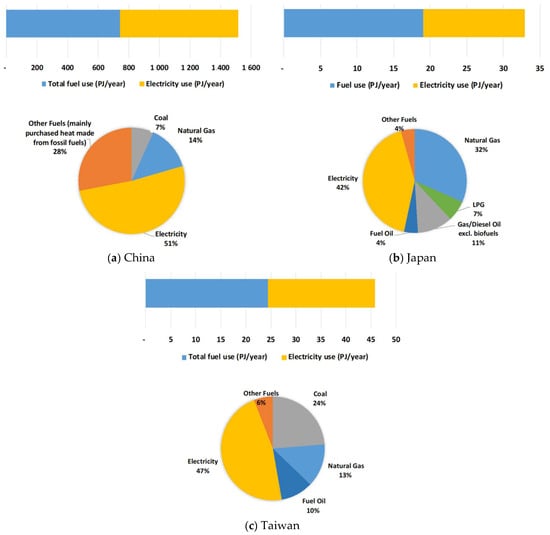
Figure 1.
Fuel and electricity used in the textile industry in China, Japan, and Taiwan in 2019 (Data source: IEA [17]).
The textile industry in Japan used about 33 PJ of final energy in 2019 [17] (refer to Figure 1b). In Japan, electricity has a share of 42% in the total final energy demand, as opposed to 51% in the Chinese textile industry. This difference is probably because of the large fabric-only production in China, which may not necessarily be going through wet processing and is instead exported to other countries. Natural gas has the highest share, i.e., 33% of the total final energy demand (see Figure 1b). The energy-related CO2 emissions from the Japanese textile industry were estimated close to 3.1 Mt CO2 in 2019.
The textile industry in Taiwan used about 46 PJ of energy in 2019 [17] (refer to Figure 1c). The share of electricity was found to be approximately 47% of the total final energy demand. Coal has the highest share among the fossil fuels consumed, i.e., 24% of the total final energy demand followed by natural gas (see Figure 1c). The total energy-related CO2 emissions from the Taiwanese textile industry were estimated to be around 5.2 Mt CO2 in 2019.
2.2. Breakdown of Energy Demand by End-Use
Energy is used for different end-uses or unit operations in a textile plant. Figure 2 shows the final energy use breakdown by end-use in the U.S. textile industry [18]. Unfortunately, a similar breakdown is not available for the textile industry in China, Japan, and Taiwan. Although the shares presented can vary from one economy to another, Figure 2 indicates the final energy demand by end-use applications in the textile industry. However, it is important to note that the textile industry in the U.S. most likely does not include as many labor-intensive processes such as yarn spinning and textile weaving as it does in developing economies such as China and Taiwan, where the relative labor costs are substantially lower. The figure shows that machine drive systems (including compressed air, pumps, fans, material processing, etc.) process heating (direct-fired systems and thermal oil boilers) and boilers have the highest share of the end-use energy demand in the U.S. textile industry. Process heat demand by thermal oil boilers is estimated to be less than 10% of the total fuel demand in the textile industry [19], as also assumed in this study for the three economies. The end-user systems that use fuel such as boilers, process heating, and cogeneration can be impacted by electrification in the textile industry.
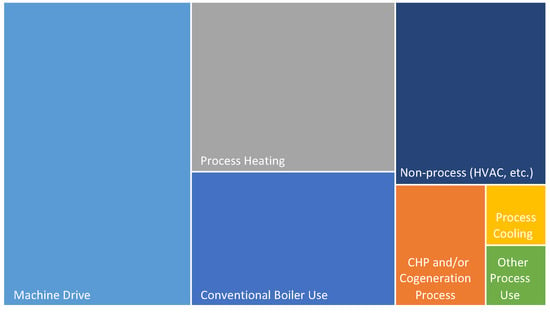
Figure 2.
Textile industry’s energy use by end-users in the U.S. in 2018 (Data source: U.S. DOE/Energetics [18]).
An integrated textile plant usually consists of spinning, knitting or weaving, and wet processing (including preparation, printing or dyeing, and finishing) at the same facility. Figure 3 illustrates the typical thermal energy and electricity consumption breakdown in an integrated textile plant [20]. The figure shows that spinning demands the greatest share of electricity (41%), followed by weaving (including preparation for weaving; 18%). The greatest share of thermal energy (50%) is consumed by wet-processing preparation (e.g., de-sizing, scouring, mercerizing, bleaching, etc.), dyeing and printing, and finishing. A significant amount of energy is also wasted during steam generation and distribution (35%). As stated earlier, wet processing consumes the most heat and steam. Hence, an electrified heat supply for wet processing possesses a great opportunity for fossil fuel demand reduction and CO2 abatement in the textile industry.
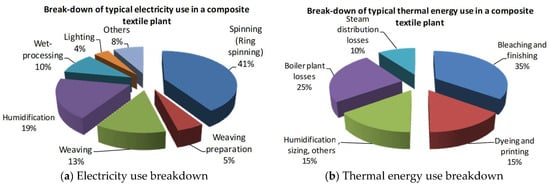
Figure 3.
Breakdown of typical electricity and thermal energy used in an integrated textile plant (Source: [20]).
2.3. Techno-Economic Analysis
Combustion boilers, using fossil fuels to generate process heat in the form of steam and thermal oil, are dominant in the global textile industry. Water-tube boilers and fire-tube boilers are the most common types of combustion boilers deployed in the industry sector. Electric boilers have a small market share for heat and steam generation in the textile industry due to several techno-economic reasons. Given the high efficiency of electric boilers (95–99% efficiency) [8,9], they can have a large contribution to decarbonizing the textile industry.
This study employs a bottom-up approach to investigate the techno-enviro-economic potentials of deploying electric steam boilers for heat and steam generation in the textile industry in China, Japan, and Taiwan up to 2050. The efficiency of combustion boilers (ηCB) in the Chinese, Taiwanese and Japanese textile industries is assumed as 80%, while the efficiency of an electric boiler (ηEB) is taken as 99% based on [7]. Similarly, the efficiencies of thermal oil boilers and their alternative electric boilers are taken as 85% and 98%, respectively, based on [21,22]. These efficiency levels are used to estimate the potential electricity demand in the future due to the electrification of steam and thermal oil boilers in textile manufacturing.
Potential energy savings (ES) due to the electrification of heat demand in the industrial processes can be estimated by Equation (1). Energy savings are calculated as the difference between heat (fuel) demand by current processes (ECB) and potential electricity demand by an electrified technology (EEB) for the same energy service. Similarly, potential CO2 abatement (CA) due to electrification and simultaneous decarbonization of the electricity grid can be determined by Equation (2).
where
ECB = Current heat demand (fossil fuels for either steam or hot oil) by textile processes;
EEB = Potential electricity demand by an electric boiler for the same energy service.
where
fw = Weighted average fossil fuel emission factor, see Table 1

Table 1.
Weighted average fuel CO2 emission factors for the textile industry (kg CO2/GJ) (calculated based on [17]).
fgrid = National average electricity grid emission factor, see Table 2.

Table 2.
Electricity grid’s CO2 emission factor (kg CO2/MWh).
The change in energy demand and CO2 emissions estimated for the textile industries are the total technical potentials that assume a 100% rate of adoption. However, the actual adoption of electrified heating technologies in the textile industry will be gradual over time. Furthermore, the potential change in energy demand is in terms of final energy, which means electricity use is not converted to primary energy using the average efficiency for power generation and transmission and distribution losses.
Costs of energy conservation (CES) and CO2 abatement (CCA) due to electric steam and thermal oil boilers’ applications are calculated using the following equations:
Costs of conserved energy
Costs of CO2 abatement
where
I = Capital investment costs of electric steam and thermal oil boilers;
O&M = Annual operations and maintenance costs of electric boilers;
B = Annual cost benefits (or annual energy cost savings), calculated by Equation (5);
α = Annuity factor (or capital recovery factor), calculated by Equation (6).
where
PF = Weighted average fossil fuel price for the textile industry, see Table 3;

Table 3.
Energy prices for industry (2021 US$/kWh).
r = Real discount rate, taken as 10% from the private industry perspective
L = Lifetime of electric boilers assumed as 20 years
The capital costs (including equipment and installation costs) of electric steam and thermal oil boilers are estimated based on the international literature [7,23,24,25]. These capital costs are further corrected for China and Taiwan where needed using a cost adjustment factor estimated based on regional differences. The annual operations and maintenance costs are taken to be 1% of the capital investment costs. Furthermore, it should be noted that since annual benefits (B) in Equations 3 and 4 are expressed as negative values as a consequence of energy cost savings, marginal costs that fall below zero are considered cost-effective.
To better understand annual benefits, energy costs of current and electrified boiler technologies are expressed per unit of physical production under the following two scenarios: (1) assuming no CO2 price, and (2) assuming a price for CO2 emissions (refer to Table 4). The current manufacturing of finished textile products in China (26 Mt), Taiwan (0.60 Mt), and Japan (0.57 Mt) are assumed to remain the same until 2050 (the production levels in the base year are assumed primarily based on [26]). Furthermore, the energy costs per unit of physical production are highly sensitive to the unit energy price (i.e., electricity and fossil fuels). However, the projections of energy prices are very uncertain. Additionally, prices of renewable electricity could decrease more significantly up to 2050 than what has been assumed in the base case scenario, making electric boilers economically more attractive. To address this low renewable electricity price scenario, a sensitivity analysis is conducted concerning the unit electricity price in the form of error bars on the plots presenting energy costs. More specifically, the error bars indicate the energy cost per unit of physical production when the unit electricity price is decreased by half.

Table 4.
The assumed carbon price in this study (2021 US$/t CO2).
3. Results and Discussion
3.1. Electrifying the Textile Industry through Electric Steam Boilers
Using the methods described in Section 2, potential applications of electric steam boilers in the textile industry in China, Japan, and Taiwan are investigated. The results show that the electrification of steam boilers could substantially reduce the annual final energy demand for steam generation in the textile industry in these three economies up to 2050 (Figure 4). Approximately 84, 2.2, and 2.3 PJ per year of annual boiler energy demand in the textile industry in China, Japan, and Taiwan, respectively, can be saved if the existing combustion boilers are electrified. This is equal to approximately 19% of the total boiler energy demand in the three economies. The annual energy saving potentials shown in Figure 4 are projected to remain at the same level in future years because this study assumes that the amount of textile production and, consequently, the energy and steam demand in the textile industry in each economy will remain more or less the same during 2021–2050.
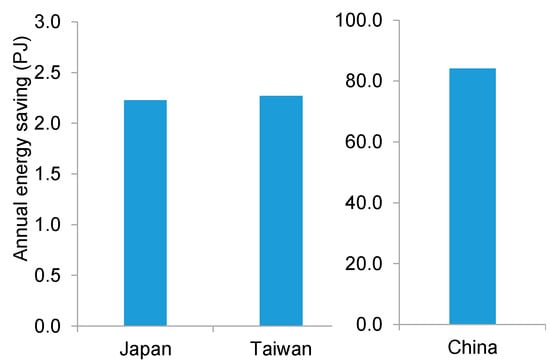
Figure 4.
Total annual final energy savings after electrification of steam boilers in the textile industry in China, Japan, and Taiwan up to 2050.
If the average national grid electricity is used, the electrification of combustion steam boilers in the textile industry in China, Japan, and Taiwan could initially lead to an increase in annual CO2 emissions by around 11,000, 110, and 51 kt CO2 in 2030, respectively (assuming a 100% adoption rate), refer to Figure 5a–c. This is because the estimated average electricity grid emission factors for these three economies in 2030 are still much higher than the weighted average emission factors of the fuel used in combustion steam boilers. However, boiler electrification is projected to result in 27,300, 736, and 856 kt CO2 of annual CO2 abatement in 2050, as also shown in the same figures. This substantial decrease in future annual CO2 emissions is projected as the consequence of electricity grid decarbonization up to 2050 (we assumed the electricity grid will be carbon neutral in 2050 in all three economies).
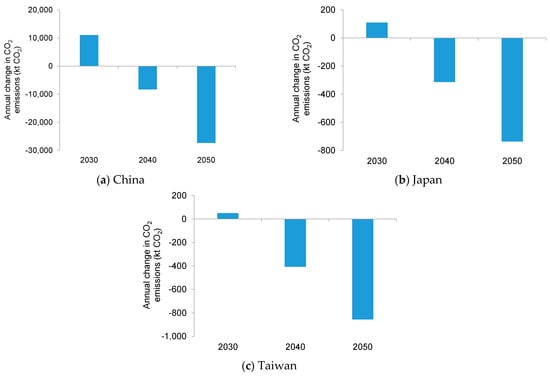
Figure 5.
Potential change in steam boilers’ annual CO2 emissions after electrification in the textile industry in China, Japan, and Taiwan.
Figure 6, Figure 7 and Figure 8 present the costs of conserved energy and CO2 abatement for electric boiler applications for steam generation in the economy-specific textile industry under a no CO2 price scenario in different timeframes. The costs of conserved energy and CO2 abatement under different CO2 price scenarios in the three economies from 2030 until 2050 are given in Appendix A. CO2 abatement costs for 2030 are not shown in the figures because, in 2030, CO2 emissions increase instead of decrease (see earlier discussion). The results show that industrial boiler electrification incurs additional costs for each economy and none of the economy-specific energy and CO2 conservation costs fall below zero which would have otherwise represented cost savings. It is, hence, concluded that although there may be some cost-effective opportunities for electrifying boilers in specific industrial sites, the overall costs are economically less attractive. The major reasons for the marginal costs being high are the large disparity between the electricity and fuel prices and the limited increase in efficiency, i.e., by 14% points.

Figure 6.
Cost of conserved energy and CO2 abatement for electric steam boilers in the textile industry in China.

Figure 7.
Cost of conserved energy and CO2 abatement for electric steam boilers in the textile industry in Japan.

Figure 8.
Cost of conserved energy and CO2 abatement for electric steam boilers in the textile industry in Taiwan.
This study also estimated the energy costs per unit of production (USD per ton of finished fabric) for the textile industry in each economy (see Figure 9, Figure 10 and Figure 11). In all three economies, switching from combustion steam boilers to electric boilers will result in substantially higher energy costs per ton of finished fabric produced in 2030, even though electric boilers result in 19% energy savings compared with combustion steam boilers. This is primarily because the electricity prices in all three economies are substantially higher than fossil fuel prices per unit of energy (kWh) (refer to Table 3). The energy costs for electric steam boilers become more competitive in 2050, but still higher than that of combustion steam boilers. This is partly because of our assumptions that fuel prices up to 2050 will increase at a higher rate than the electricity prices in these three economies, and partly because of an increase in assumed carbon price in the future (see Section 2.3).
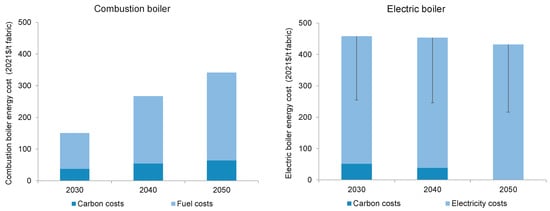
Figure 9.
Energy costs per unit of production for combustion and electric steam boilers in the textile wet-processing industry in China.
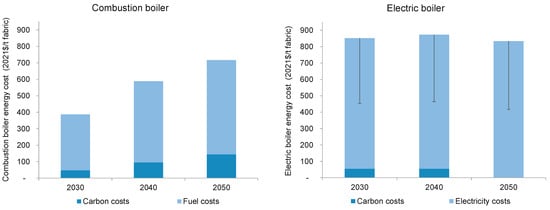
Figure 10.
Energy costs per unit of production for combustion and electric steam boilers in the textile wet-processing industry in Japan.
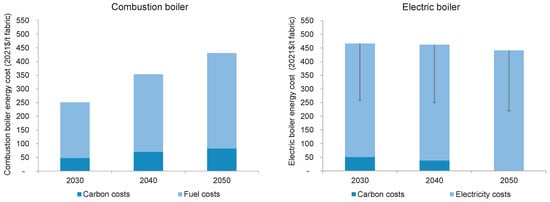
Figure 11.
Energy costs per unit of production for combustion and electric steam boilers in the textile wet-processing industry in Taiwan.
3.2. Electrifying the Textile Industry through Electric Thermal Oil Boiler
Potential applications of electric thermal oil boilers in the textile industry in China, Japan, and Taiwan are further investigated in this study. The results show that electrification could substantially reduce the annual final energy demand for thermal oil boilers in the Chinese, Taiwanese, and Japanese textile industries by 2050 (refer to Figure 12). Approximately 13% of the annual thermal oil boiler energy demand in the textile industry can be saved if the existing fossil-fuel-fired thermal oil boilers are electrified. This results in annual final energy savings of 35, 0.91, and 0.91 PJ per year in China, Japan, and Taiwan, respectively. As stated earlier, the energy savings potential shown in the figure remains at the same level because this work assumes that the heat demand provided by thermal oil boilers in the textile industry in each economy will remain the same until 2050 (conservative assumption).

Figure 12.
Total annual energy saving after electrification of thermal oil boilers in the textile industry in China, Japan, and Taiwan up to 2050.
With average national grid electricity, the electrification of thermal oil boilers in the textile industry in China, Taiwan, and Japan could initially lead to an increase in annual CO2 emissions by around 8470, 100, and 70 kt CO2, respectively (assuming a 100% adoption rate), refer to Figure 13a–c. This is because the electricity grid in the three economies is not projected to be decarbonized enough in 2030, based on our assumptions. However, thermal oil boiler electrification will result in 16,560, 440, and 500 kt of annual CO2 abatement by 2050. This substantial decrease in future annual CO2 emissions is projected as a consequence of electricity grid decarbonization between 2021 and 2050. Like the case for the electric steam boiler discussed earlier, if a given textile plant in any economy electrifies its thermal oil boilers today and purchases renewable electricity to supply the electricity demand of the electric thermal oil boiler, then the CO2 emissions reductions from electrification can be achieved immediately.
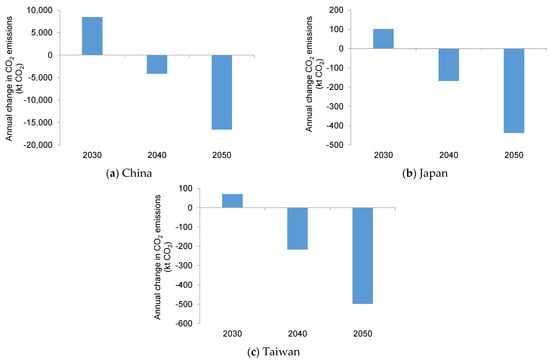
Figure 13.
Potential change in thermal oil boilers’ annual CO2 emissions after electrification in the textile industry in China, Japan, and Taiwan.
Figure 14, Figure 15 and Figure 16 present the costs of conserved energy and CO2 abatement for electric boiler applications for hot oil production in the economy-specific textile industry under no CO2 price scenarios in different timeframes. The marginal costs under different CO2 price scenarios in the three countries until 2050 are given in Appendix B. As discussed earlier, since the CO2 emissions increase in 2030 due to thermal oil boiler electrification, the corresponding CO2 abatement costs do not exist. The trends and the corresponding reasons are found to be the same as in the case of electric steam boilers (refer to the previous section).

Figure 14.
Cost of conserved energy and CO2 abatement for electric thermal oil boilers in the textile industry in China.

Figure 15.
Cost of conserved energy and CO2 abatement for electric thermal oil boilers in the textile industry in Japan.

Figure 16.
Cost of conserved energy and CO2 abatement for electric thermal oil boilers in the textile industry in Taiwan.
This study further estimates the energy costs per unit of production for the textile industry in each economy (refer to Figure 17, Figure 18 and Figure 19). Like in the case of the electric steam boilers, in all three economies, switching from combustion thermal oil boilers to electric boilers results in substantially higher energy costs per ton of finished fabric produced in 2030, even though electric boilers result in 13% energy savings compared with combustion steam boilers. This is primarily because the electricity prices in all three economies are substantially higher than fossil fuel prices per unit of energy (kWh) (see Table 3). The energy costs for electric thermal oil boilers become more competitive in 2050, but still higher than that of combustion thermal oil boilers.
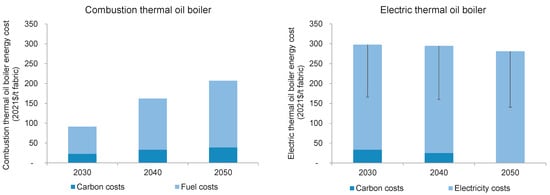
Figure 17.
Energy costs per unit of production for combustion and electric thermal oil boilers in the textile industry in China.
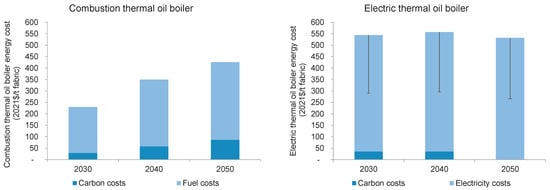
Figure 18.
Energy costs per unit of production for combustion and electric thermal oil boilers in the textile industry in Japan.
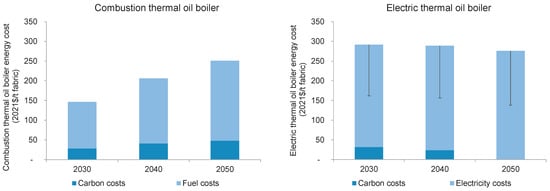
Figure 19.
Energy costs per unit of production for combustion and electric thermal oil boilers in the textile industry in Taiwan.
3.3. Overall Summary
The total annual energy savings and CO2 abatement due to the electrification of both steam and thermal oil boilers in the textile industry in all three economies are presented in this section. The electrification of boilers could lead to annual total final energy savings of approximately 119, 3.9, and 3.1 PJ per year in China, Taiwan, and Japan, respectively, in 2050. If the electricity from the 2030 grid is used, the electrification of steam and thermal oil boilers slightly increases the CO2 emissions from the textile industry. However, a substantial reduction in emissions can be anticipated in 2040 and 2050 due to large-scale grid decarbonization and energy efficiency improvements. The annual reduction in CO2 emissions in 2050 is estimated at approximately 44, 1.4, and 1.2 Mt CO2 per year in China, Taiwan, and Japan, respectively.
It is important to note that while industrial electrification decreases net final energy consumption, it increases electricity consumption. Electrifying steam and thermal oil boilers will increase annual electricity consumption by 168, 4.5, and 4.4 TWh per year in China, Taiwan, and Japan, respectively, in 2050. This increase may directly translate into a rise in electricity load of over 35, 1.1, and 1.0 GW in China, Taiwan, and Japan, respectively, in 2050. For comparison, note that China had around 2380 GW, Taiwan had around 59 GW, and Japan had around 313 GW of power generation capacity in 2021 [27,28]. To calculate the aforementioned additional loads, this study assumes that all additional loads are based on renewable energy sources. More specifically, to estimate the capacity factors, this study assumes that two-thirds and one-third of the additional loads will be coming from solar and wind power, respectively.
Industrial electrification in the textile industry has the potential to reduce a significant amount of CO2 emissions when the electricity grid is substantially decarbonized, however, the competing demands for renewable electricity resources and infrastructure pose significant challenges to achieving emissions reduction in the three economies. The electricity grid is a complex, interconnected system that links generation resources to end consumers with variable electricity demands. Managing electricity grid resources, infrastructure, and flow of energy is a considerable undertaking that will continue to be complicated by a shift towards more distributed generation, renewables adoption, and electrification. Furthermore, the current electricity grid systems will be further strained as different economic sectors, including buildings and transportation in addition to industry, adopt electrified technologies for accessing renewable resources and decreasing emissions. Investing in the electricity grid and increasing the share of renewables in the power sector energy portfolio will help to accelerate electrification and contribute to CO2 abatement.
4. Discussion and Recommendations
While there are numerous benefits to electrifying industrial processes, including reduced energy demand and emissions, barriers still inhibit the development and deployment of electrified technologies. This section discusses the following most impactful recommendations that would support increased electrification in the textile industry. These changes will require numerous actors to work together to solve significant challenges in renewable electricity generation and transmission, technology development and deployment, and workforce development.
Increase renewable electricity generation capacity: Top priority should be given to increasing renewable electricity generation capacity and the decarbonization of the electric grid in the three economies studied in this report and the rest of the world so that CO2 emissions reductions go hand in hand with electrification initiatives undertaken by textile manufacturers and apparel brands. To achieve that aim, governments should consider financial incentives that reduce renew-able energy costs and carbon taxes that increase the costs of fossil fuels. To be successful, it is also essential that governments develop a coherent power sector strategy that pays attention to the potential rapid increase in demand and competition for renewable electricity across many sectors and end uses, and the subsequent need for additional renewable electricity generation, additional energy storage, and demand response programs. The strategy to increase renewable electricity should incentivize the development of distributed renewable energy generation at industrial sites as well as the central grid. Apparel brands can work with their textile suppliers in China, Japan, and Taiwan to increase investment in offsite renewable electricity generation projects and/or work with governments and power utilities through industry groups to demonstrate demand for clean electricity for electrification projects.
Enhance the electricity grid: As stated earlier, the industrial, transportation, and building industries are all working to increase electrification and renewable electricity use, requiring significant amounts of renewable electricity resources to be added to the resource mix. This increased demand across sectors will not only require additional renewable electricity supply, but also an electric transmission and distribution system that can adequately manage the increased energy volume in China, Japan, and Taiwan. Electric utilities will need to examine the impact of increased electricity demand on the system as a whole. New and upgraded equipment will be needed to meet the increasing demand. Given the increase in severe weather events that result from climate change, the electricity grid will also need to be hardened to ensure its resilience and reliable electricity supply to industry and other sectors. Resiliency measures will depend on local conditions. Appropriate hardening efforts will likely be different in coastal communities than they are in regions that receive significant amounts of snow and ice, and urban and rural areas may find different approaches most effective. It will be necessary for power to flow seamlessly from one part of the country/region to another, bringing renewable electricity from where it is generated to where it will be consumed by industrial customers. For grid upgrades too, it is critical to engage communities where new or upgraded equipment will be located or where its impacts will be felt.
Support demonstration of emerging electrification technologies and new applications of existing technologies: Government and industry can work together to support technology demonstration and deployment. The technologies considered in this study are commercially available and ready for deployment. In cases where an “off-the-shelf” solution is not possible, textile companies can work with original equipment manufacturers to further develop and refine electrified technologies that meet their specific process and application requirements. Textile companies should also initiate partnerships with academia, think tanks and other stakeholders to develop and/or scale electrification technologies. In addition, textile companies should develop business cases for electrification technologies by including both energy and non-energy benefits.
Financially incentivize electrification: Energy prices can vary significantly from economy to economy or even from region to region within the same economy. Comparisons of the cost per unit of production shown in this study are highly sensitive to the unit price of energy. It is anticipated that renewable electricity prices will continue to decline and may decline faster than predicted. This would make electrification technologies more competitive with conventional fossil fuel-based technologies. Therefore, this analysis considers the costs of electrification using both the baseline forecasted prices as well as prices 50% lower for electricity up to 2050. In addition, natural gas and other fossil fuel prices may increase more than projected, especially if a carbon pricing policy is introduced that includes the textile industry and the price of carbon increases up to 2050. It should be noted that the energy cost is only a small portion of the total manufacturing cost in the textile industry. A small or even moderate increase in energy cost per unit of the product resulting from electrification will have a minimal impact on the price of the final textile and apparel product. Therefore, it will have minimal impact on the price that final consumers will pay for the product or products made from those materials.
Furthermore, governments and manufacturers may be able to reduce costs, especially for pilot or demonstration projects, by accessing public financial, technical, or program support. Governments may also implement their policies and programs aimed at reducing costs associated with electrification technology adoption. Such policies could include tax incentives, reduced permitting costs, rate-based utility infrastructure upgrade costs, etc. Grants for switching to electrified technologies would reduce textile manufacturers’ upfront costs, incentivizing changes. Grants could be made for pilot projects to encourage early adoption and demonstrate success. The way utility rates are structured can also incentivize electrification. Electricity rates vary across China, Japan, and Taiwan, so individualized approaches appropriate to each economy would be needed.
It should be noted that demand charges could disincentivize electrification becausee newly electrified processes establish a new, higher peak hourly demand for a facility. However, if textile plants can be flexible about their electricity consumption and can manage to avoid generating large peaks, they may be able to reduce their electricity bills. Textile plants may also benefit from time-of-use rates by shifting their processes’ run times to take advantage of lower electricity prices. The adoption of electricity storage systems can also assist industrial plants to manage peak electricity demand and accommodate additional renewable electricity generation [14,29].
Finally, financiers require additional information about electrification technologies and their benefits. Those that could provide financing for electrified technologies may not be aware of industrial electrification’s benefits or companies’ interest in pursuing it as a way to reduce energy use and emissions. A better understanding of industrial electrification technologies’ capabilities and the need for additional investment and support can improve policy and investment decisions.
Develop the workforce: Employees and contractors at textile production facilities may require training on new technologies and their installation, operation, and maintenance. Governments can utilize their educational programs in high schools, technical schools, community colleges, and universities to provide training on current electrified technologies and ensure that the future workforce is ready to develop the next generation of technologies. Governments should look across their agencies and offices, including education, higher education, energy, public utility commission, and economic development, to receive input on educational program development. Input from utilities, industrial companies, trade associations, teachers, and students will also be valuable to ensure training programs are meeting current and future needs. Those developing the workforce should engage with underserved communities and work together to develop relevant educational and training programs to ensure these communities can equitably participate in the clean energy economy.
5. Conclusions
This study presents the energy savings and CO2 abatement potentials and their associated costs for electric boilers applicable in the textile industry in China, Japan, and Taiwan. It is a detailed analysis of the effects of the electrification of steam, hot water, and thermal oil production in textile industries in the period 2021–2050. Firstly, detailed profiles of boiler energy demand in the economy-specific textile industry are established and disaggregated by type of fuel and end-use. To quantify the techno-economic potential for electrifying process heating in textile plants, this study investigates cases for the wide-scale application of electric steam and thermal oil boilers under different price and emission scenarios and provides a range of costs of electrification and performance data.
The results show that the total annual potential energy savings due to the electric steam boiler applications in the textile industry are estimated to be around 84, 2.2, and 2.3 PJ per year in China, Japan, and Taiwan, respectively, in 2050. This is equal to approximately 19% of the total boiler energy demand in the three economies. Similarly, annual potential energy savings of 35, 0.91, and 0.91 PJ per year can be realized if the existing fossil-fuel-fired thermal oil boilers are electrified in the textile industry in China, Japan, and Taiwan, respectively, in 2050. Moreover, the potential CO2 abatement resulting from the electrification is highly dependent on the carbon intensity of the electricity used. More specifically, if the average national grid electricity is used, the electrification of combustion steam boilers in the textile industry in China, Japan, and Taiwan could initially lead to an increase in annual CO2 emissions by around 11, 0.11, and 0.05 Mt CO2 in 2030, respectively (assuming a 100% adoption rate). This is because the estimated average electricity grid emission factors for the three economies in 2030 are found to be much higher than the weighted average emission factors of fuel used in combustion steam boilers. However, steam boiler electrification is projected to result in 27.3, 0.7, and 0.9 Mt of annual CO2 abatement in 2050. Similarly, thermal oil boiler electrification could result in 16.5, 0.4, and 0.5 Mt of annual CO2 abatement in 2050. This substantial decrease in future annual CO2 emissions is projected as the consequence of electricity grid decarbonization up to 2050 (assuming the electricity grids will be carbon neutral in 2050 in all three economies).
The costs of conserved energy and CO2 abatement due to electric boiler applications in the economy-specific textile industry under different energy and CO2 price scenarios in different timeframes are also estimated. The economic analysis shows that boiler electrification incurs additional costs for each economy and none of the economy-specific energy and CO2 conservation costs are estimated to be less than zero, which would have otherwise represented cost savings. Therefore, it is concluded that although there may be some cost-effective opportunities for electrifying boilers in specific textile plants, the overall costs are rather expensive. The results further show that switching from fossil-fuel-fired steam and thermal oil boilers to electric boilers may result in higher energy costs primarily because the average electricity prices in all three economies are substantially higher than fossil fuel prices. Hence it is further concluded that the cost-effective opportunities to adopt electric boilers in the textile industry may only continue to expand as electricity prices drop and combustion fuel prices increase in the future.
Despite the numerous benefits of electrifying thermal processes in the textile industry, including reduced energy demand and emissions, barriers still inhibit the development and deployment of electrified technologies. To overcome the barriers, this study provides several recommendations that will require all stakeholders, including textile plants, policymakers, utility companies, etc., to work together to solve significant challenges in renewable electricity generation and transmission, technology development and deployment, and workforce development. It is also concluded that wide-scale electrification of steam and thermal oil demand in the textile industry will require major changes to the electricity system and individual sites in China, Japan, and Taiwan, and it is important to step up the coordination efforts to plan these changes as early as possible.
Author Contributions
A.H.: Conceptualization, Methodology, Data Curation, Project administration, Funding acquisition, Resources, Formal analysis, Visualization, Writing—Original Draft; M.J.S.Z.: Conceptualization, Methodology, Data Curation, Resources, Visualization, Writing—Review and Editing. All authors have read and agreed to the published version of the manuscript.
Funding
This work is made possible with the support from Patagonia (under contract ID: 997AE4F1-D7E2-45FC-B1D9-DDC0C02BC175) and supplemental funding contributions from (in no particular order) the Outdoor Industry Association, REI, New Balance, Burton, and Gore.
Data Availability Statement
Not applicable.
Acknowledgments
The authors would like to thank Kim Drenner of Patagonia, Sarah Rykal and Amy Horton of the Outdoor Industry Association, Markus Wieser of Gore, Matthew Thurston, Evan Scandling, and Lyn Ip of REI, John Stokes of New Balance, Emily Foster of Burton, Linda Greer, Azizul Hoque of Global Efficiency Intelligence, Bryant LaPres of Apparel Impact Institute, Fu Wei Tsao and Hwong-when Ma from National Taiwan University, and Hongyou Lu and William Morrow from Lawrence Berkeley National Laboratory for their valuable input to this study and/or their insightful comments on the earlier version of this document. The views expressed by the authors do not necessarily reflect the views of any of the organizations and/or individuals.
Conflicts of Interest
The authors declare no conflict of interest.
Appendix A. Costs of Conserved Energy and CO2 Abatement for Electric Steam Boilers under the CO2 Price Scenario

Figure A1.
Cost of conserved energy and CO2 abatement for electric steam boilers under the CO2 price scenario in the textile industry in China.

Figure A2.
Cost of conserved energy and CO2 abatement for electric steam boilers under the CO2 price scenario in the textile industry in Japan.

Figure A3.
Cost of conserved energy and CO2 abatement for electric steam boilers under the CO2 price scenario in the textile industry in Taiwan.
Appendix B. Costs of Conserved Energy and CO2 Abatement for Electric Thermal Oil Boilers under the CO2 Price Scenario

Figure A4.
Cost of conserved energy and CO2 abatement for electric thermal oil boilers under the CO2 price scenario in the textile industry in China.

Figure A5.
Cost of conserved energy and CO2 abatement for electric thermal oil boilers under the CO2 price scenario in the textile industry in Japan.

Figure A6.
Cost of conserved energy and CO2 abatement for electric thermal oil boilers under the CO2 price scenario in the textile industry in Taiwan.
References
- Sadowski, M.; Perkins, L.; McGarvey, E. Roadmap to Net Zero: Delivering Science-Based Targets in the Apparel Sector; World Resources Institute: Washington, DC, USA, 2021. [Google Scholar]
- Yin, W.; Xu, B. Effect of Online Shopping Experience on Customer Loyalty in Apparel Business-to-Consumer Ecommerce. Text. Res. J. 2021, 91, 2882–2895. [Google Scholar] [CrossRef]
- World Trade Organization. World Trade Statistical Review. 2021. Available online: https://www.wto.org/english/res_e/statis_e/wts2021_e/wts21_toc_e.htm (accessed on 13 October 2022).
- Patwary, S. Clothing and Textile Sustainability: Current State of Environmental Challenges and the Ways Forward. Text. Leather Rev. 2020, 3, 158–173. [Google Scholar] [CrossRef]
- Pulat, E.; Etemoglu, A.B.; Can, M. Waste-Heat Recovery Potential in Turkish Textile Industry: Case Study for City of Bursa. Renew. Sustain. Energy Rev. 2009, 13, 663–672. [Google Scholar] [CrossRef]
- Park, J.; Jin, T.; Lee, S.; Woo, J. Industrial Electrification and Efficiency: Decomposition Evidence from the Korean Industrial Sector. Energies 2021, 14, 5120. [Google Scholar] [CrossRef]
- Zuberi, M.J.S.; Hasanbeigi, A.; Morrow, W.R. Electrification of Boilers in U.S. Manufacturing; Lawrence Berkeley National Laboratory: Berkeley, CA, USA, 2021. [Google Scholar]
- Madeddu, S.; Ueckerdt, F.; Pehl, M.; Peterseim, J.; Lord, M.; Kumar, K.A.; Krüger, C.; Luderer, G. The CO2 Reduction Potential for the European Industry via Direct Electrification of Heat Supply (Power-to-Heat). Environ. Res. Lett. 2020, 15, 124004. [Google Scholar] [CrossRef]
- Bühler, F.; Zühlsdorf, B.; Nguyen, T.-V.; Elmegaard, B. A Comparative Assessment of Electrification Strategies for Industrial Sites: Case of Milk Powder Production. Appl. Energy 2019, 250, 1383–1401. [Google Scholar] [CrossRef]
- Nielsen, M.G.; Morales, J.M.; Zugno, M.; Pedersen, T.E.; Madsen, H. Economic Valuation of Heat Pumps and Electric Boilers in the Danish Energy System. Appl. Energy 2016, 167, 189–200. [Google Scholar] [CrossRef]
- Zuberi, M.; Jibran., S.; Hasanbeigi, A.; Morrow, W. Bottom-up Assessment of Industrial Heat Pump Applications in U.S. Food Manufacturing. Energy Convers. Manag. 2022, 272, 116349. [Google Scholar] [CrossRef]
- Aurousseau, A.; Vuillerme, V.; Bezian, J.-J. Control Systems for Direct Steam Generation in Linear Concentrating Solar Power Plants—A Review. Renew. Sustain. Energy Rev. 2016, 56, 611–630. [Google Scholar] [CrossRef]
- Sugimat. Thermal Oil Boilers. Sugimat. 2022. Available online: https://www.sugimat.com/en/products/thermal-oil-boilers/ (accessed on 26 October 2022).
- Hasanbeigi, A.; Kirshbaum, L.A.; Collison, B.; Gardiner, D. Electrifying U.S. Industry: Technology and Process-Based Approach to Decarbonization; Global Efficiency Intelligence: San Francisco, CA, USA, 2021. [Google Scholar]
- Schüwer, D.; Schneider, C. Electrification of Industrial Process Heat: Long-Term Applications, Potentials and Impacts. In Proceedings of the European Council for an Energy Efficient Economy, Stockholm, Sweden, 15 June 2018; pp. 411–422. [Google Scholar]
- Schoeneberger, C.; Zhang, J.; McMillan, C.; Dunn, J.B.; Masanet, E. Electrification Potential of U.S. Industrial Boilers and Assessment of the GHG Emissions Impact. Adv. Appl. Energy 2022, 5, 100089. [Google Scholar] [CrossRef]
- IEA World Energy Statistics. 2020. Available online: https://www.iea.org/data-and-statistics/data-product/world-energy-statistics (accessed on 13 October 2022).
- U.S. DOE/Energetics Manufacturing Energy and Carbon Footprints (2018 MECS). 2022. Available online: https://www.energy.gov/eere/amo/manufacturing-energy-and-carbon-footprints-2018-mecs (accessed on 4 April 2022).
- Hasanbeigi, A.; Zuberi, M.J.S. Electrified Process Heating in Textile Wet Processing Industry: A Techno-Economic Analysis for China, Japan, and Taiwan. Energies 2022, 15, 8939. [Google Scholar] [CrossRef]
- Hasanbeigi, A. Energy-Efficiency Improvement Opportunities for the Textile Industry; Lawrence Berkeley National Laboratory: Berkeley, CA, USA, 2010. [Google Scholar]
- SiTong. YLW Series Hot Oil Boiler. 2022. Available online: https://www.stong-boiler.com/v1/products/more/hot-oil-boiler.html (accessed on 26 October 2022).
- Leway Boiler. Electric Heating Boilers, Electric Heating Steam Boilers, Electric Heating Hot Water Boilers. 2022. Available online: https://www.chinaleway.com/product/33.html (accessed on 26 October 2022).
- Zuberi, M.; Jibran., S.; Chambers, J.; Patel, M.K. Techno-Economic Comparison of Technology Options for Deep Decarbonization and Electrification of Residential Heating. Energy Effic. 2021, 14, 75. [Google Scholar] [CrossRef]
- Alibaba. Electrical Hot Oil Boiler-Electrical Hot Oil Boiler Manufacturers, Suppliers and Exporters. 2022. Available online: https://www.alibaba.com/trade/search?fsb=y&IndexArea=product_en&CatId=&tab=all&SearchText=ELECTRICAL+HOT+OIL+BOILER (accessed on 26 October 2022).
- Alibaba. China Factory Electric Industrial Heater Boiler. 2022. Available online: https://www.alibaba.com/product-detail/China-Factory-Electric-Industrial-Thermal-Hot_1600408944415.html?spm=a2700.galleryofferlist.normal_offer.d_title.244820e2shWZBW (accessed on 26 October 2022).
- Groz-Beckert. The Fabric Year 2017. 2017. Available online: https://www.groz-beckert.com/mm/media/web/9_messen/bilder/veranstaltungen_1/2017_6/the_fabric_year/Fabric_Year_2017_Handout_EN.pdf (accessed on 26 October 2022).
- U.S. EIA. International—China. 2021. Available online: https://www.eia.gov/international/analysis/country/CHN (accessed on 14 October 2022).
- Japan Electric Power Information Center (JEPIC). The Electric Power Industry in Japan. 2022. Available online: https://www.jepic.or.jp/pub/pdf/epijJepic2022.pdf (accessed on 14 October 2022).
- Deason, J.; Wei, M.; Leventis, G.; Smith, S.J.; Schwartz, L.C. Electrification of Buildings and Industry in the United States: Drivers, Barriers, Prospects, and Policy Approaches; Lawrence Berkeley National Laboratory: Berkeley, CA, USA, 2018. [Google Scholar]
Publisher’s Note: MDPI stays neutral with regard to jurisdictional claims in published maps and institutional affiliations. |
© 2022 by the authors. Licensee MDPI, Basel, Switzerland. This article is an open access article distributed under the terms and conditions of the Creative Commons Attribution (CC BY) license (https://creativecommons.org/licenses/by/4.0/).